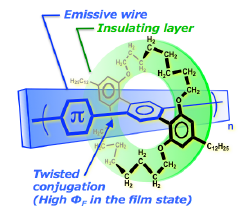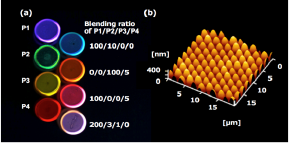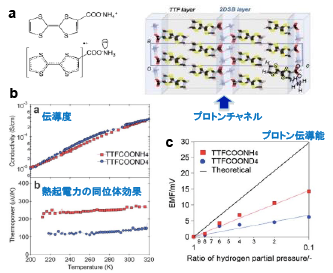Group
有機材料グループ Organic Materials Group
Result H25


K. Sugiyasu et al., Angew. Chem. Int. Ed., 2013, 52, 10775.
共役系高分子1本を立体的に被覆することによって、薄膜状態でも高い発光量子収率を有する高分子材料の創製に成功しました。これらの高分子は、共通の環状分子で覆われているため、ブレンド性に優れ、これによって様々な発光色を合成することができます。
We have synthesized highly fluorescent polymeric materials through isolating conjugated polymer backbones. These polymers are miscible in the polymer blends, which enables to generate various fluorescent colors.

Y. Kobayashi et al., J. Mater. Chem. A, 2013, 1, 5089.
現在ほとんど活用されていない室温付近の熱エネルギーの有効利用が求められており、 有機熱電物質はその加工性の高さからその日常の廃熱を効率よく回収するための有力な材料としての期待が高まっている。 そのような背景の中、 純有機物のみで構成された有機半導体結晶中で、 理論式から予想されるよりずっと大きな熱起電力を発現する系を実現した。 ここでは、イオンキャリアが重要な役割を担っており、 熱電特性向上のための物質設計に関する新しい知見が得られた。
Ammonium proton in a solid ionic semiconductor, TTFCOONH4, is shown to be mobile under anhydrous conditions at room temperature by the hydrogen concentration cell method. Isotope substituted TTFCOOND4 exhibits a 2.2 H/D isotope effect in ion carrier mobility with TTFCOONH4. First-principles calculations reveal that an efficient proton-transfer pathway via low-barrier NH+N hydrogen bonds reduces the activation energy to 0.12 eV, which is quite small and comparable to that reported in a bulk water system. The ac conductivity of TTFCOONH4 and TTFCOOND4 is similar at room temperature, reflecting similar hole carrier concentrations. In sharp contrast, the thermopower exhibits a large isotope effect: TTFCOONH4 shows 260 μV K−1, which is twice as large as that predicted by the hole carrier concentration and the value of TTFCOOND4, with 138 μV K−1. The 1.9 H/D isotope effect in thermopower closely relates to the 2.2 H/D isotope effect in ion carrier mobility. Proton carriers in the temperature gradient enhance thermopower without cancelling out the effect of holes in the solid state owing to possession of the same positive charge.
